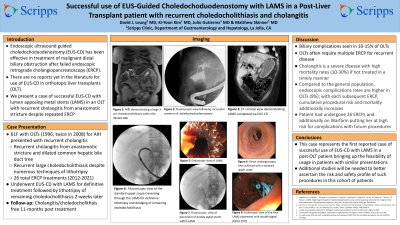Back


Poster Session A - Sunday Afternoon
Category: Interventional Endoscopy
A0436 - Successful Use of EUS-Guided Choledochoduodenostomy With LAMS in a Post-Liver Transplant Patient With Recurrent Choledocholithiasis and Cholangitis
Sunday, October 23, 2022
5:00 PM – 7:00 PM ET
Location: Crown Ballroom

Has Audio
.jpg)
David Leung, MD
Scripps Green-Scripps Clinic
La Jolla, CA
Presenting Author(s)
David Leung, MD, Ki-Yoon Kim, MD, Julio A. Gutierrez, MD, Matthew J. Skinner, MD
Scripps Green-Scripps Clinic, La Jolla, CA
Introduction: Biliary complications, like anastomotic stricture and cholangitis, are seen in 10-15% of orthotopic liver transplants (OLT). OLTs often require multiple endoscopic retrograde cholangiopancreatoscopy (ERCP) for recurrent disease. Endoscopic ultrasound guided choledochoduodenostomy (EUS-CD) has been effective in treatment of malignant distal biliary obstruction after failed ERCP; however, there are limited reports regarding EUS-CD in OLTs. We present a case of successful EUS-CD with lumen apposing metal stents (LAMS) in an OLT with recurrent cholangitis secondary to benign anastomotic stricture refractory to management with ERCP.
Case Description/Methods: A 61-year old female with 3 OLTs (1996 and twice in 2008) for autoimmune hepatitis presented with recurrent cholangitis secondary to anastomotic biliary stricture in the setting of duct mismatch with a dilated common hepatic bile duct to 3 cm. She had recurrent choledocholithiasis measuring 3 cm despite prior mechanical and electrohydraulic lithotripsy with cholangioscopy confirmed clearance. As a result, she had undergone a total of 26 prior ERCP treatments (2012-2021). She underwent an EUS-CD with LAMS for definitive treatment. 2-weeks later, an upper endoscope was traversed through the LAMS to perform lithotripsy of remaining choledocholithiasis. At this time, the patient remains free of cholangitis for the past 8 months.
Discussion: Biliary complications, like anastomotic stricture and recurrent cholangitis, are a common occurrence in OLTs. With use of various ERCP techniques, obstructions can be removed or ameliorated. Timely treatment of cholangitis is imperative as the mortality rate is high (10-30%). With each cholangitis episode and subsequent ERCP, the cumulative procedural risk and mortality increases. EUS-CD has been demonstrated to be effective in treatment for malignant distal biliary obstruction after failed ERCP. Our patient had previously undergone 26 ERCPs and additionally was on Warfarin for pulmonary embolism putting her at very high risk for complications with additional future endoscopic procedures. This represents a case of successful use of EUS-CD with LAMS in a patient post-OLT with a significant distal common bile duct stricture which had been refractory to traditional management via ERCP. Long term studies are indicated to see if this can provide durable benefit.

Disclosures:
David Leung, MD, Ki-Yoon Kim, MD, Julio A. Gutierrez, MD, Matthew J. Skinner, MD. A0436 - Successful Use of EUS-Guided Choledochoduodenostomy With LAMS in a Post-Liver Transplant Patient With Recurrent Choledocholithiasis and Cholangitis, ACG 2022 Annual Scientific Meeting Abstracts. Charlotte, NC: American College of Gastroenterology.
Scripps Green-Scripps Clinic, La Jolla, CA
Introduction: Biliary complications, like anastomotic stricture and cholangitis, are seen in 10-15% of orthotopic liver transplants (OLT). OLTs often require multiple endoscopic retrograde cholangiopancreatoscopy (ERCP) for recurrent disease. Endoscopic ultrasound guided choledochoduodenostomy (EUS-CD) has been effective in treatment of malignant distal biliary obstruction after failed ERCP; however, there are limited reports regarding EUS-CD in OLTs. We present a case of successful EUS-CD with lumen apposing metal stents (LAMS) in an OLT with recurrent cholangitis secondary to benign anastomotic stricture refractory to management with ERCP.
Case Description/Methods: A 61-year old female with 3 OLTs (1996 and twice in 2008) for autoimmune hepatitis presented with recurrent cholangitis secondary to anastomotic biliary stricture in the setting of duct mismatch with a dilated common hepatic bile duct to 3 cm. She had recurrent choledocholithiasis measuring 3 cm despite prior mechanical and electrohydraulic lithotripsy with cholangioscopy confirmed clearance. As a result, she had undergone a total of 26 prior ERCP treatments (2012-2021). She underwent an EUS-CD with LAMS for definitive treatment. 2-weeks later, an upper endoscope was traversed through the LAMS to perform lithotripsy of remaining choledocholithiasis. At this time, the patient remains free of cholangitis for the past 8 months.
Discussion: Biliary complications, like anastomotic stricture and recurrent cholangitis, are a common occurrence in OLTs. With use of various ERCP techniques, obstructions can be removed or ameliorated. Timely treatment of cholangitis is imperative as the mortality rate is high (10-30%). With each cholangitis episode and subsequent ERCP, the cumulative procedural risk and mortality increases. EUS-CD has been demonstrated to be effective in treatment for malignant distal biliary obstruction after failed ERCP. Our patient had previously undergone 26 ERCPs and additionally was on Warfarin for pulmonary embolism putting her at very high risk for complications with additional future endoscopic procedures. This represents a case of successful use of EUS-CD with LAMS in a patient post-OLT with a significant distal common bile duct stricture which had been refractory to traditional management via ERCP. Long term studies are indicated to see if this can provide durable benefit.

Figure: Figure 1A. MRI imaging demonstrating a large 3 cm choledocholithiasis within the dilated CBD, which formed as a result of bile stasis. 1B. CT coronal view demonstrating successful deployment of LAMS to complete EUS-CD. 1C. Fluoroscopic view of the standard upper scope traversing through the LAMS for definitive lithotripsy and dredging of remaining choledocholithiasis. 1D. Endoscopic view of the final LAMS placement with double pigtail plastic stents.
Disclosures:
David Leung indicated no relevant financial relationships.
Ki-Yoon Kim indicated no relevant financial relationships.
Julio Gutierrez indicated no relevant financial relationships.
Matthew Skinner: Boston Scientific – Consultant.
David Leung, MD, Ki-Yoon Kim, MD, Julio A. Gutierrez, MD, Matthew J. Skinner, MD. A0436 - Successful Use of EUS-Guided Choledochoduodenostomy With LAMS in a Post-Liver Transplant Patient With Recurrent Choledocholithiasis and Cholangitis, ACG 2022 Annual Scientific Meeting Abstracts. Charlotte, NC: American College of Gastroenterology.
